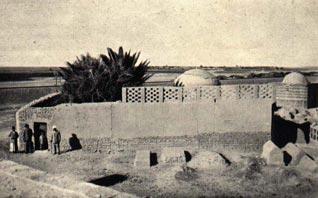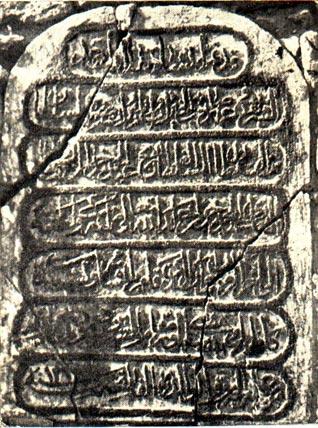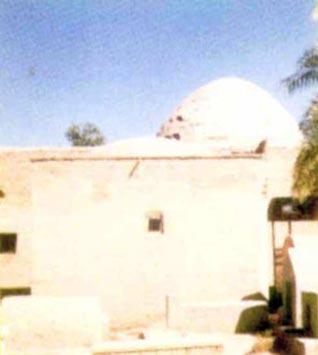History
Guru Nanak's Foot-Prints in Baghdad's Sands
by ANWAR FARUQI
A desolate courtyard surrounded by fields of mournful graves is all that remains of an ancient shrine to the Sikh faith's founder, Guru Nanak, inside a sprawling Muslim cemetery in Baghdad, Iraq
War and indiscriminate bombing by U.S. forces, insurgents and looters have wiped any trace of a historical footnote that had preserved the memory of the holy man's 16th-century journey through Arabia and his stay in Baghdad, hailed by Sikhs as an early example of inter-faith dialogue.
"No one visits anymore," lamented Abu Yusef, the lean and bearded Muslim caretaker, standing in the nearly-bare patio where a disorderly stack of broken electric fans and a discarded refrigerator replace the prayer books and articles of Sikh worship that had furnished a shrine whose modesty mirrored the humility of the man it honoured.
"Before the war a few Sikh pilgrims would occasionally arrive," Abu Yusef said, referring to the 2003 U.S.-led invasion that toppled ex-dictator Saddam Hussein and unleashed an unending cycle of violence.
"Once or twice we even had Western tourists. Last year, after a very long time, a Sikh man came from Dubai who promised to return and rebuild the shrine. But since then, nobody," he said with a resigned shrug of the shoulders.
When they came, the pilgrims would stay a night or two and convert the shrine into a gurdwara, Abu Yusef recalled.
"They slept in the courtyard, where they also cooked large quantities of food to share after worship with whoever came along," he remembered, pointing to the places in the roofless, sun-beaten enclosure with whitewashed walls and a plain concrete dais that had housed prayer books, painted portraits of the Guru and a prized stone plaque from the 16th century.
What is known about the origins of the site, which lies today inside central Baghdad's expansive Sheikh Marouf cemetery that adjoins a disused train station where decaying railroad cars rest frozen on rusted tracks, is gleaned from scant historical sources.
One is a Punjabi hymn by the poet and philosopher Bhai Gurdas, written several decades after the visit.
Inter-faith Dialogue
That song, part of the holy scriptures of the world's 30 million Sikhs, recounts Nanak's travels with the Muslim minstrel Mardana who was his constant companion, their arrival in Baghdad and lodging outside the city.
In Baghdad, say historical Sikh sources, the pair stayed with Sheikh Bahlool Dana, a renowned Sufi Muslim of the time.
"It is curious that the hymn recording Guru Nanak's visit says that he chose to stay outside Baghdad, which at the time was a wealthy, magnificent city and an important centre of learning," said Abdul Majid Padar, India's learned charge d'affaires in Baghdad.
"That probably means he had reason to stay outside the city," he said. "I believe it was because he knew about Sheikh Bahlool, and went looking for him."
Nanak, an enlightened spiritual thinker who was born a Hindu but gained deep knowledge of Islam as India's other major religion at the time, travelled throughout his homeland and parts of the Middle East, seeking other men of his ilk.
He shunned religious labels, teaching that man is judged by deeds, not the religion he proclaims. His ideas, which later formed the basis of the monotheistic Sikh religion, drew from Hinduism and Islam, but are regarded as much broader than a mere synthesis of the two.
"Guru Nanak's stay with Sheikh Bahlool was an early example of inter-faith dialogue, of a kind that is hard to imagine in Iraq today," said Dr. Rajwant Singh of the the Sikh Council on Religion and Education in the United States.
Iraq has been torn by sectarian strife since the fall of Saddam, with Shiites, Sunnis and even the country's small Christian community victims of the bloodshed.
It is in the courtyard of the Muslim Bahlool's own humble tomb that, five centuries ago, the remembrance to Guru Nanak was erected.
"This shrine is very much sacred to the Sikhs as it stands testimony to Guru Nanak's visit and dialogue with the Muslim Sufi sheikh of that place," said Balwant Singh, professor of Sikh studies at the Guru Nanak Dev University in India.
Modern accounts of the shrine date back to World War I when the site was rediscovered, after being lost in obscurity for centuries, by a regiment of Indian Sikh soldiers sent to Iraq with the British army.
Dr. Kirpal Singh, a Sikh captain in the Indian medical service who travelled to Iraq, described the shrine in a letter dated October 15, 1918.
"It is really a humble looking building and known to very few people except Sikhs," he said in an account quoted by the SikhSpectrum.com online journal.
Other accounts and faded photographs reveal an ancient stone plaque at the entrance, commemorating the building of the memorial, as the centrepiece of the shrine. The plaque was dated 917 on the Islamic calendar, or 1511 A.D.
Pritpal Kaur, who visited Baghdad in 1968 with her late husband, in-laws and three children, said she was moved to be standing at the same spot as the Great Guru.
Spread message of peace
"I really got a great feeling as I was standing on the same site visited by Guru Nanak Sahib. It was a very emotional feeling," said Pritpal, who was 31 at the time and living in neighbouring Kuwait.
"It was a very small, simple structure of about 600 square feet (56 square metres). There was a large courtyard outside. Not many Sikhs used to visit at all," said Pritpal, who is now 73 and living in the United States.
"Definitely, the most precious thing at the shrine was the ancient plaque that verified the legitimacy of the site," she said.
Curiously, it was the hymn by Bhai Gurdas that probably led to the rediscovery of the shrine. Subedar Fateh Singh, one of the Sikh soldiers in Iraq during World War I, announced the discovery in 1918.
"I am certain that Fateh Singh knew about the shrine from the hymn, which he must have learned in childhood, and he went looking for it," said Padar, the Indian embassy charge.
The shrine was repaired by Sikh soldiers in the early 1930s, and reportedly again during World War II, when another regiment of Sikh soldiers was stationed in Iraq.
But accounts of what happened more recently to the shrine and its contents, including the 16th century plaque precious to Sikhs, are sketchy.
Shortly after the March 20, 2003 invasion of Iraq, Indian media reports variously said the shrine had been damaged or destroyed by US shelling, with other accounts claiming it had been bombed by Islamic extremists.
But a visit to the shrine showed no hint of damage anywhere in or around the shrine, raising the possibility that everything, including the stone plaque, was likely looted.
Abu Yusef, the caretaker, said he had been away at the time of the invasion and did not know what had happened and Padar, the Indian charge, said his own understanding of an attack during the war had come from news reports.
But with the gurdwara building gone, the only footsteps of the Sikh holy man's journey through Baghdad remain in the memories of visitors like Pritpal Kaur.
"It greatly saddens me," she said about the shrine's destruction.
"It signified Guru Nanak's wish to spread his message of peace, love and a rejection of superstitions and rituals in search of the truth," she said.
"He yearned to spread this message throughout the world, and he travelled on foot from Punjab to deliver it."
[Courtesy: Sify]
January 26, 2011
Conversation about this article
1: Gurjender Singh (Maryland, U.S.A.), January 26, 2011, 11:48 AM.
There was news in 2009 that Punjab government rebuilt a mosque in Patiala, which belonged to an Imam, a Iraqi Muslim. After looking at the rebuilt mosque, the Iraqi Imam promised the Punjab Government that they will rebuild the gurdwara in Baghdad. What happened to those promises made by the Iraqi Imam? Is the S.G.P.C. aware of any of this?
2: Saime (Milton Keynes, England), January 26, 2011, 1:22 PM.
A very thought provoking article. It makes me proud that I am a follower of the great Guru Nanak from whose message I have learned so much. The last paragraph saddens me somewhat: "He yearned to spread his message ..." We, his followers, settled in East Africa as early as 1920's but we did not spread that brilliant message to a single African. I am not sure if Sikhs who settled in in Malaysia, Singapore, U.S.A. (except Yogi ji), United Kingdom, Canada, etc., did differently. Why is that our gurdwaras spread our Gurus' message to Punjabis only?
3: Gurdip Singh Chana (London, United Kingdom), January 27, 2011, 6:13 AM.
Saime ji: I am in the same boat as you - just wondering why we Sikhs are lagging behind. In particular, today's world is looking for a religion to guide it. Christianity is diminishing; not many people taking interest due to its complications. Hinduism is full of rituals and contradictory methods. Buddhism is becoming like Hinduism. Shintoism and other faiths in the similar category - such as Jainism - are not interesting for any member of the public. Judaism is a very old faith and not many people actively convert to that faith. This leaves just Sikhi and Islam in this world for consideration. The former is less known than the latter. That is why I'm witnessing many western people in the U.K. converting to Islam and on the other hand in the U.S. many convert to Sikhi as well as other faiths. We Sikhs need reforming; our institutions, people, etc - but our reforms begin at home before they spread to others. I have considered on many occasions to give up all the worldly aims and to just dedicate my life to working in Sikhi. I want to live my life as a Sikh to improve our state of affairs - unfortunately we have very few people living as true Sikhs, so how can we make others Sikhs. I see Sikhs in bars, strip joints, etc. up and down the country - how can we lead others to follow Sikhi when we ourselves are not doing good. I am not doing good either - but I am bloody well trying to reform myself! I hope Waheguru gives me strength to do this. I hope other Sikhs also reform themselves. We have made many gains in certain areas of our faith, but we have either gone back or not made progress in other areas also; it is these areas which need urgent attention; and I am sure the Sikh Sangat can easily identify many areas of improvement quite easily.
4: Saime (Milton Keynes, United Kingdom), January 27, 2011, 3:19 PM.
Gurdip Singh ji: Your message conveys a feeling that you have a deep yearning in you to become a better Sikh and help all others around you to understand Sikhi more. Guru Nanak went on his Udaasis (travels) to remote lands to spread his message. Guru Gobind Singh gave away his leadership (power) to the Punj Pyare - us! You can make a difference - it only takes one. As they say, out of a hundred one person is a doer, ten just watch and have some understanding but the rest do not have a clue, they just follow like sheep. Pursue your inner yearning and dreams. "jan naanak tis balihaaranai jo aap japai avaraa naam japaa-ai" - 'Servant Nanak is a sacrifice to him who himself chants the Naam, and inspires others to chant it as well.' I like what you said. Together, we can bring about change! Rab Raakha.
5: Harpal Singh Grewal (Canada), January 28, 2011, 5:13 PM.
It is so pitiful to read that there is hardly any Sikh nowadays who goes to see the site commemorating Guru Nanak's visit to Baghdad. I know that here in Canada, as well as in the U.S.A. or any country where Sikhs are the residents, large gurdwaras are being built. That's praiseworthy, but isn't it important that we first ensure that our historical places are well looked after. Here in North America we have Sikh senators, governors, premiers, cabinet ministers, MPs, etc; can't we seek their assistance?
6: Dr Pawan Kumar (Pakistan), November 08, 2011, 8:54 AM.
I am a doctor from Pakistan currently posted in Sharjha, UAE, and want to know if any gurdwara sahib associated with Baba Guru Nanak in India is located near a river.
7: Bhai Harbans Lal (Dallas, Texas, USA), August 17, 2012, 5:34 PM.
There are many gurdwaras on the banks of the river associated with Guru Nanak's life and visit. Send me an email at japji08@yahoo.com and I will send you specific information.
8: Navdeep Singh (Chandigarh, Punjab), March 13, 2015, 8:33 AM.
Could anyone tell me about the exact location of the gurdwara in Baghdad? Is it possible to go there now?





